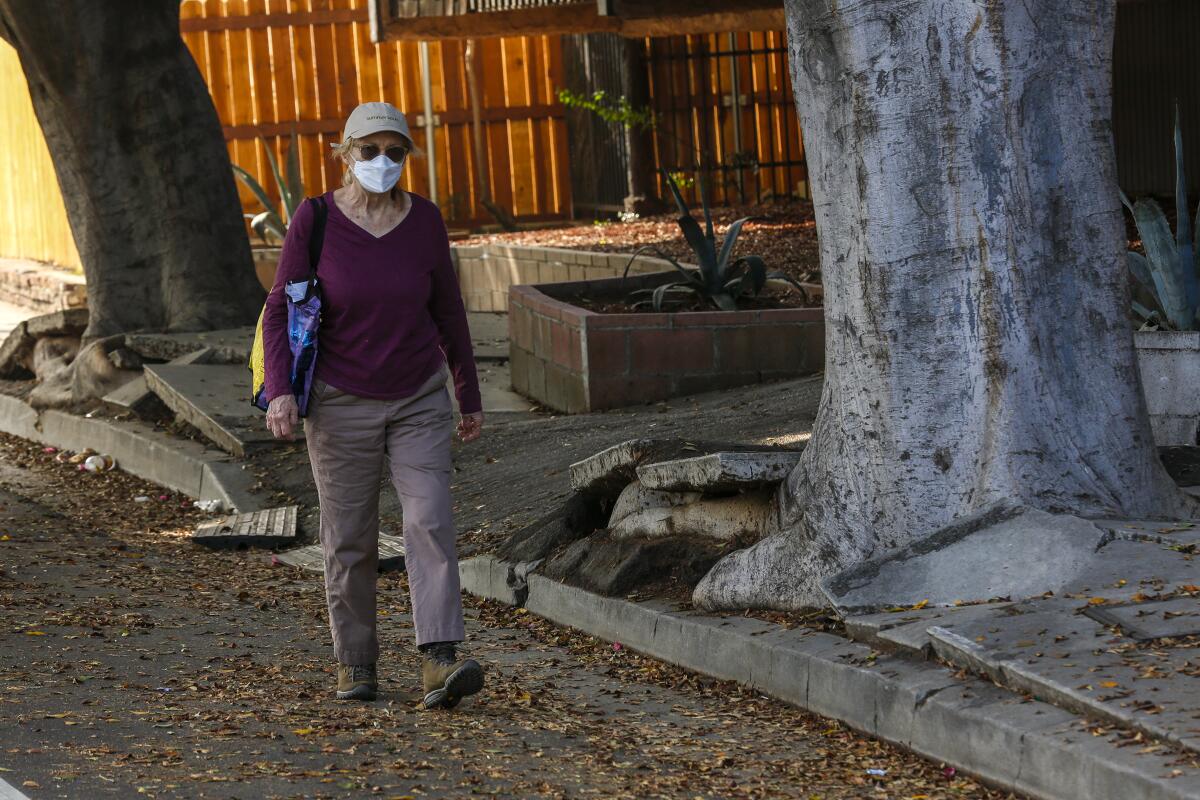Editorial: L.A. tripped over its duty to fix the city’s broken sidewalks

- Share via
Sidewalks are essential transportation infrastructure in dense, urban Los Angeles, but thousands of miles of walkways are broken, cracked and dangerous. At the current level of funding and with fixes delayed by inefficient repair policies, Angelenos may have to wait centuries for safe, smooth sidewalks, according to a recent audit.
That’s unacceptable.
Sidewalks are crucial to community livability. Broken sidewalks make it dangerous for the average pedestrian to simply walk down the street, and make travel nearly impossible for the disabled. The lack of safe sidewalks also undermines the city’s environmental and equity goals. How can we expect Angelenos to forgo polluting cars when walking on city sidewalks is a risky endeavor?
And the ongoing failure to fix the sidewalks costs taxpayers millions of dollars a year, City Controller Ron Galperin wrote in a recent audit of the city’s sidewalk repair program. L.A. has been hit with more than 1,700 claims and 1,020 lawsuits for sidewalk injuries over the last five years, and paid out more than $35 million in settlements.
The problem goes back decades. More than 45 years ago, the city adopted a well-intentioned but ultimately disastrous law that transferred the responsibility for fixing sidewalks damaged by tree roots from property owners to the city. But the city never fulfilled its maintenance obligation and by about 2010, roughly half of the city’s sidewalks were in bad condition.
In 2016, Mayor Eric Garcetti and the City Council settled a lawsuit brought by disabled residents over the dire condition of the city’s sidewalks by committing to spend $1.4 billion over the next 30 years on sidewalk repairs. Around the same time, city leaders adopted a “fix and release” policy under which the city would repair the sidewalks first and then return responsibility to property owners.
But that fix-and-release program is moving too slowly, Galperin said. The city is choosing to rebuild entire stretches of sidewalk rather than just focusing on the damaged segments. Fewer than 1% of the city’s sidewalk parcels — 640,000 in all — have been certified as repaired and turned over to property owners; at this rate it could take 500 years to certify all the sidewalks, the controller said.
Plus, the city doesn’t track how many sidewalks need repair — it mostly relies on residents to call in complaints — or how much all the work will cost. And it still takes the city much longer — 41 days on average — to temporarily patch a broken sidewalk than the three days it takes to fill a pothole in the street.
And that gets to the heart of the problem: Sidewalks are treated as second-class transportation infrastructure, compared with streets and highways. L.A. has many millions of dollars from local transportation sales tax, plus state and federal infrastructure funding, but the city still only dedicates a fraction of its budget to sidewalk repairs. The results are evident in the buckled, crumbling concrete across L.A.
It’s time that Los Angeles leaders live up to their pledge to make this a more walkable and livable city. It’s time to treat and fund sidewalks as an essential piece of the city’s transportation network.
More to Read
A cure for the common opinion
Get thought-provoking perspectives with our weekly newsletter.
You may occasionally receive promotional content from the Los Angeles Times.










